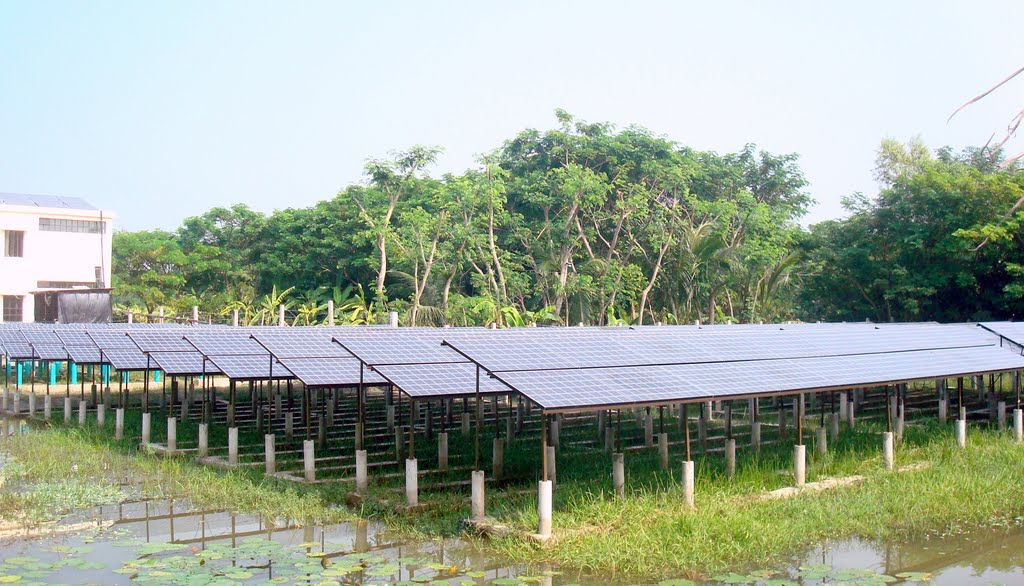Electricity, the very thing bringing these words to your eyes, is inaccessible to 45 percent of Bangladesh's population. Fewer than half the people living in the country's rural areas are on the power grid at all. That's why the Solar Home System Project, launched in 2007, is particularly good news for Bangladesh. A partnership between the state-owned Infrastructure Development Company Limited (a World-Bank-funded project) and about 40 NGOs (including private-sector companies and microcredit agencies), the Solar Home System Project has helped bring electricity and lightning to roughly 3 million homes, affecting more than 20 million lives.
Recently, Bangladesh celebrated the successful installment of 3 million solar home systems. The accomplishment reflects years of hard work. Naomi Ahmad celebrated the feat in a tweet earlier this month:
#Bangladesh celebrated installation of 3 million #solar homes systems this month. Remembering all the killer work we put in for last year!
— Naomi Ahmad (@NaomiAhmad) November 11, 2014
Greenpeace has commented very favorably on the project, crediting it with aiding a solar-energy revolution:
Has the world been ignoring the largest #Solar revolution? It's in our subcontinent #Bangladesh http://t.co/tsRrE2fwnM #RenewableEnergy
— Greenpeace India (@greenpeaceindia) October 27, 2014
Bangladeshis are installing solar home systems at a rate of 65,000 every month. Energy specialist Zubair K M Sadeque studies why the solar home system is becoming more popular. He says the reasons include rising rural income, strong microfinance support from local NGOs, and LED lighting innovation.
Bangladesh, in particular, has great potential when it comes to solar power. The country is located between 200 30’ and 260 45’ north latitude and the climate is tropical. This is ideal for solar-power reception. In fact, Bangladesh receives sufficient solar energy 300 days out of the year.
Solar energy is also finding its way into agriculture. Bangladesh has approved the construction of 191 solar-based irrigation pumps. (Sixty-nine are already up and running.) Solar energy also plays an important role in rural businesses. Villagers can now keep their shops, medicine stores, and saloons open late into the night. This has increased working hours, income, and living standards.
Installing solar panels hasn't been cheap in Bangladesh, but blogger Probir Bidhan encourages the country to move ahead with the process:
#Solar is still too expensive in #Bangladesh but needed badly to be spread quickly! http://t.co/eeIKqA1CxD
— probirbidhan (@probirbidhan) November 4, 2014
Currently, 40 percent of the Bangladeshi population is unemployed. The unemployment rate is increasing every year, but solar home systems have helped alleviate this, creating more than 114,000 jobs in the assembly, sale, installation, and maintenance of solar power systems. In fact, the number of solar-related jobs nearly doubled between 2011 and 2013.
Mike Hudema is a climate and energy campaigner. He tweeted about green jobs in Bangladesh:
#GreenJobs Booming in #Bangladesh-80,000 home #solar units a month! http://t.co/PQXiMLojhb #cdnpoli #tarsands #abpoli pic.twitter.com/rMjMMljhKR
— Mike Hudema (@MikeHudema) June 21, 2014
Commercial installations of solar home systems in Bangladesh began officially in 1996. Grameen Shakti, a concern of Grameen Bank, started the trend. In the past 18 years, Grameen Shakti has installed more than 1.3 million solar home panels.








3 comments
“…installment of 3 millions systems…”
Should be “installation”, because “installment” is a financial term meaning “payment”.
However, the news is good; those solar batteries, once commercially viable, will be a big spike into oilers’ asses.
My notes on a book describing the work of Grameen Shakti, Green Energy for a Billion Poor:
http://hubeventsnotes.blogspot.com/2014/04/green-energy-for-billion-poor.html